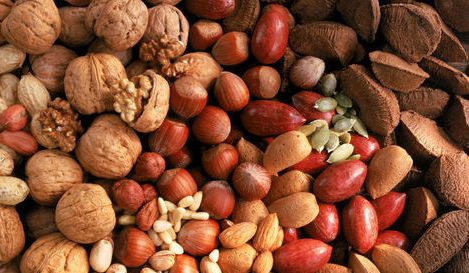VITAMINS
There are two main types of vitamins -- fat-soluble and water-soluble ones. The fat-soluble vitamins, A, D, E, and K, are stored in the body, and taking excessive amounts of them could be harmful. The water-soluble vitamins, vitamin C and the B complex vitamins, are not stored in the body and are, therefore, needed in the diet every day. Any excess amounts of these are excreted in the urine.
Vitamin A and beta-carotene
An antioxidant, vitamin A is essential for vision in dim light and for the maintenance of healthy skin and surface tissues. It is stored in the liver and is toxic in excessive amounts. Vitamin A can be made in the body from beta-carotene (often referred to as its precursor), which is found in leafy green vegetables and in orange-colored fruits and vegetables, such as carrots and apricots.
Vitamin D
Vitamin D is essential for maintaing healthy levels of calcium and phosphorus in the body and for building healthy bones and teeth. The body makes its own vitamin D through the action of sunlight on the skin. Dietary sources are of less importance, except for people who cannot go out or who do not expose their skin to the light. Thirty minutes a day is sufficient.
Vitamin E
One of the top antioxidants, vitamin E fights free radicals and helps skin stay healthy.
Vitamin K
Vitamin K helps the body to make a number of proteins, one of which is necessary for blood clotting.
The B vitamins
The vitamin B complex comprises eight vitamins: thiamin (B1), riboflavin (B2), niacin (B3), pantothenic acid (B5), pyridoxine (B6), cobalamins (B12), biotin, and folate (also known as folic acid).
Some of the B vitamins are essential for the release of energy from the foods we eat; others are involved in making cells -- some make nerve cells, which is why a deficiency of certain B vitamins may result in depression. B6, B12, and folate make red blood cells. These three also help protect the heart via their action on homocysteine, while folate helps protect unborn babies against spina bifida.
Vitamin C
Another antioxidant, vitamin C, is needed for the growth and maintenance of healthy connective tissue, for boosting immunity, and for helping the body to absorb iron.
For humans, vitamin C must come from the diet. The best sources are certain fruits, particularly black currants, strawberries, kiwi fruit, guavas, and citrus fruits. (Cashew Fruit!!) Green salads and vegetables are also useful, particularly potatoes, because of the large quantities generally eaten.
Vitamin C in fruits and vegetables diminishes with storing and cooking. Frozen vegetables may, therefore, sometimes have a higher vitamin C content than fresh vegetables that have been stored for some time.
MINERALS
Our bodies need minerals in the diet for the growth and maintenance of bones, cells, and tissues. Some minerals -- for example, zinc, iron, and chromium -- are needed only in small quantities and are called trace minerals; others are required in much larger amounts. The more important dietary minerals are calcium, iron, and zinc. Phosphorus and magnesium are also important, but a diet that provides sufficient calcium will also provide adequate phosphorus and magnesium.
Calcium
Calcium is vital for forming and continually strengthening bones and teeth. In addition to strengthening bones and teeth, calcium acts as a natural tranquilizer, soothing irritability and aiding insomnia.
Iron
Iron is particularly important for the formation of hemoglobin, the red pigment in blood. In theory, we are born with enough iron to last throughout life, however, if enough dietary iron is not eaten to restore any losses, anemia can result.
Zinc
An antioxidant, zinc is a trace mineral that helps in the healing of wounds, is involved in enzyme activity, and is essential for healthy sex organs and male reproduction.
Vitamin and mineral requirements:
The amount of each vitamin and mineral we need changes according to our age, health, gender and level of activity.
- Children generally need more vitamins because they are growing and active
- Pregnant women are advised to take supplements of folate in the first twelve weeks of pregnancy
- People over the age of 50 generally become less active so need less energy. It is, therefore, important that the food that they eat is more nutrient-dense than the average diet








